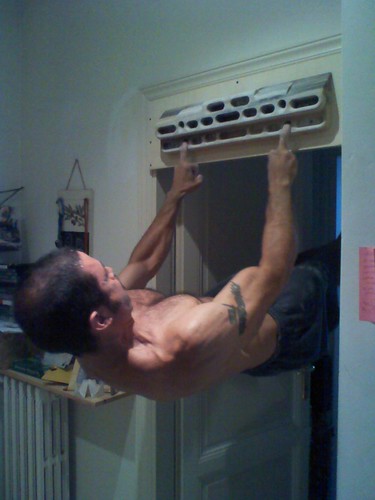One of the real problems is figuring out how to help climbers get the strength gains that will allow success on their desired projects or grade level, especially with a limited time budget. A great tool for kickstarting this process is a fingerboard. However I wonder if too much is being made of this recently. I have seen lots of discussion on various Internet sites, along with other media, about various fingerboards and whether they are useful and more importantly whether they are worth the money as most cost somewhere between 75 and 100 dollars US, a lot of money for many climbers. The purpose of this post is to encourage you to save some money and make a board that works for you.
 |
| This could be you! But probably not... and don't worry about it anyway |
I think the first myth that needs to go is whether one brand/style/etc. is better than another. The commercial message is definitely something that needs to be cut through here, though I think that manufacturers are sincere enough in trying to provide a good product. The only thing that really matters in a commercial board is avoiding rough textured plastic. Commercial fingerboards are prone to this problem and while the flexibility of molding shapes in plastic is theoretically desirable, the presence of excessive friction interferes with the primary purpose of the board, training your fingers and forearms. It can also discourage use of the board if the texture is painful. This is one thing to be said for the Beastmaker brand of fingerboards, that since they are made of hard sanded wood, the relative absence of friction is a real plus.
This brings me to the next myth, namely that shapes matter. Fingerboards have been made in a wide variety of elaborate, even baroque shapes, with ornate curved edges and sets of pockets, pinches and slopers and so on, shapes that look attractive in a catalog, ad, or website, especially with some swirly colors added in. My experience has been that these shapes provide little or no practical functionality that cannot be readily supplied by other less expensive means. At their worst, they offer shapes that could promote injury rather than progress.
Instead, I would recommend that you consider the possibilities present in a simple single edge made of wood, of first-joint depth with a gentle curved outside edge, approximately 2 feet in length, similar to a typical intermediate-size campus rung. This item will cost perhaps $2-5 and can be easily mounted to a piece of plywood (cost $5-8) if need be, or screwed directly to an exposed beam as in a cellar. You can easily add more edges of greater or lesser width by visiting a local building supplies store, probably even picking up usable pieces of wood for free in the scrap pile.
By the way, the closest "commercial" version of this concept is made by Sonnie Trotter but anyone with some simple tools and a piece of sandpaper could recreate this style very easily on their own. His board however looks very good. Whether he's actually making them right now, I don't know. I can find out.
 |
| Sonnie Trotter's V-Board |
The last myth I want to discuss, which will lead into the next post, is that a fingerboard will actually do much for you by itself. This is unlikely to be the case for a number of reasons. First climbing, while heavily dependent on finger strength, relies very much on the ability of the upper limbs to pull dynamically independently of each other, a skill best improved by either climbing or campusing. Secondly, climbing relies on effective use of body tension and foot placement something that simple hangs on a fingerboard cannot easily develop. Finally, most climbers, because of the points made above, will find it more useful to become more efficient in their time spent climbing, planning their sessions to deliberately squeeze more climbing into them in whatever time is available.
That said, the fingerboard can be, ounce for ounce, one of the most effective training tools out there. In a following post, I will discuss how to get the most from this simple inexpensive versatile apparatus.